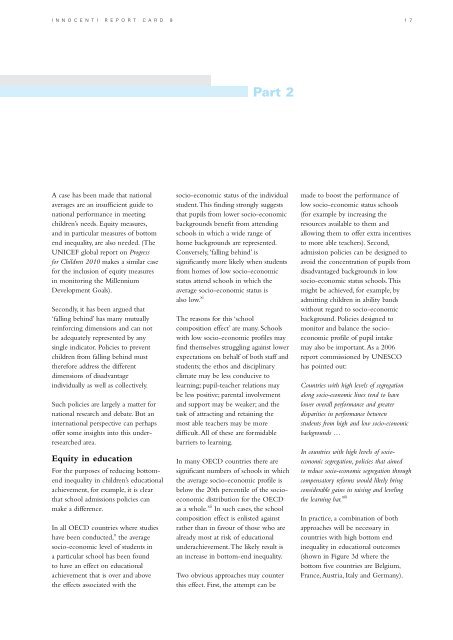The children left behind - Innocenti Research Centre
The children left behind - Innocenti Research Centre
The children left behind - Innocenti Research Centre
You also want an ePaper? Increase the reach of your titles
YUMPU automatically turns print PDFs into web optimized ePapers that Google loves.
I n n o c e n t i R e p o r t C a r d 9 1 7<br />
Part 2<br />
A case has been made that national<br />
averages are an insufficient guide to<br />
national performance in meeting<br />
<strong>children</strong>’s needs. Equity measures,<br />
and in particular measures of bottom<br />
end inequality, are also needed. (<strong>The</strong><br />
UNICEF global report on Progress<br />
for Children 2010 makes a similar case<br />
for the inclusion of equity measures<br />
in monitoring the Millennium<br />
Development Goals).<br />
Secondly, it has been argued that<br />
‘falling <strong>behind</strong>’ has many mutually<br />
reinforcing dimensions and can not<br />
be adequately represented by any<br />
single indicator. Policies to prevent<br />
<strong>children</strong> from falling <strong>behind</strong> must<br />
therefore address the different<br />
dimensions of disadvantage<br />
individually as well as collectively.<br />
Such policies are largely a matter for<br />
national research and debate. But an<br />
international perspective can perhaps<br />
offer some insights into this underresearched<br />
area.<br />
Equity in education<br />
For the purposes of reducing bottomend<br />
inequality in <strong>children</strong>’s educational<br />
achievement, for example, it is clear<br />
that school admissions policies can<br />
make a difference.<br />
In all OECD countries where studies<br />
have been conducted, x the average<br />
socio-economic level of students in<br />
a particular school has been found<br />
to have an effect on educational<br />
achievement that is over and above<br />
the effects associated with the<br />
socio-economic status of the individual<br />
student. This finding strongly suggests<br />
that pupils from lower socio-economic<br />
backgrounds benefit from attending<br />
schools in which a wide range of<br />
home backgrounds are represented.<br />
Conversely, ‘falling <strong>behind</strong>’ is<br />
significantly more likely when students<br />
from homes of low socio-economic<br />
status attend schools in which the<br />
average socio-economic status is<br />
also low. xi<br />
<strong>The</strong> reasons for this ‘school<br />
composition effect’ are many. Schools<br />
with low socio-economic profiles may<br />
find themselves struggling against lower<br />
expectations on behalf of both staff and<br />
students; the ethos and disciplinary<br />
climate may be less conducive to<br />
learning; pupil-teacher relations may<br />
be less positive; parental involvement<br />
and support may be weaker; and the<br />
task of attracting and retaining the<br />
most able teachers may be more<br />
difficult. All of these are formidable<br />
barriers to learning.<br />
In many OECD countries there are<br />
significant numbers of schools in which<br />
the average socio-economic profile is<br />
below the 20th percentile of the socioeconomic<br />
distribution for the OECD<br />
as a whole. xii In such cases, the school<br />
composition effect is enlisted against<br />
rather than in favour of those who are<br />
already most at risk of educational<br />
underachievement. <strong>The</strong> likely result is<br />
an increase in bottom-end inequality.<br />
Two obvious approaches may counter<br />
this effect. First, the attempt can be<br />
made to boost the performance of<br />
low socio-economic status schools<br />
(for example by increasing the<br />
resources available to them and<br />
allowing them to offer extra incentives<br />
to more able teachers). Second,<br />
admission policies can be designed to<br />
avoid the concentration of pupils from<br />
disadvantaged backgrounds in low<br />
socio-economic status schools. This<br />
might be achieved, for example, by<br />
admitting <strong>children</strong> in ability bands<br />
without regard to socio-economic<br />
background. Policies designed to<br />
monitor and balance the socioeconomic<br />
profile of pupil intake<br />
may also be important. As a 2006<br />
report commissioned by UNESCO<br />
has pointed out:<br />
Countries with high levels of segregation<br />
along socio-economic lines tend to have<br />
lower overall performance and greater<br />
disparities in performance between<br />
students from high and low socio-economic<br />
backgrounds …<br />
In countries with high levels of socioeconomic<br />
segregation, policies that aimed<br />
to reduce socio-economic segregation through<br />
compensatory reforms would likely bring<br />
considerable gains in raising and leveling<br />
the learning bar. xiii<br />
In practice, a combination of both<br />
approaches will be necessary in<br />
countries with high bottom end<br />
inequality in educational outcomes<br />
(shown in Figure 3d where the<br />
bottom five countries are Belgium,<br />
France, Austria, Italy and Germany).
















